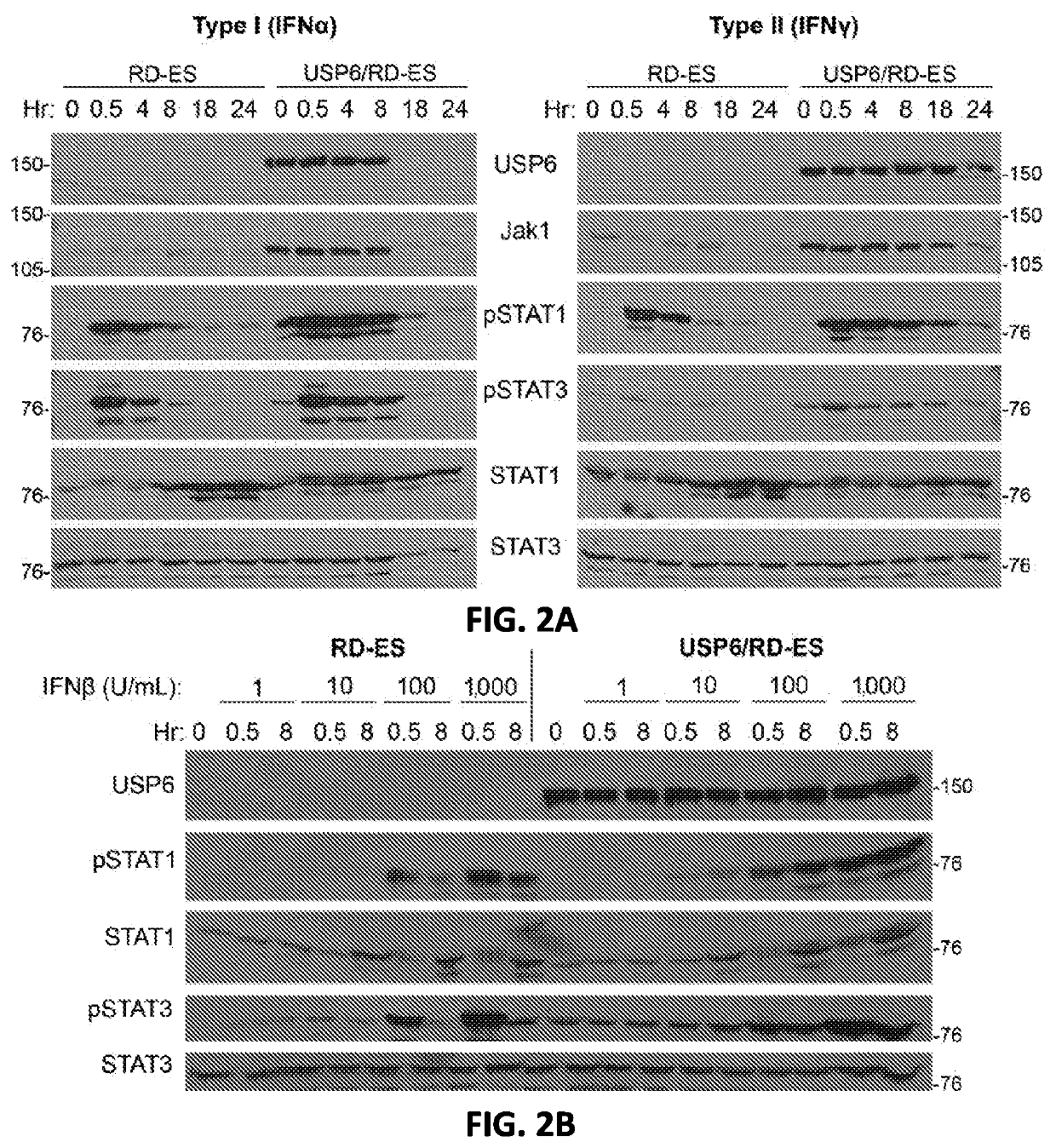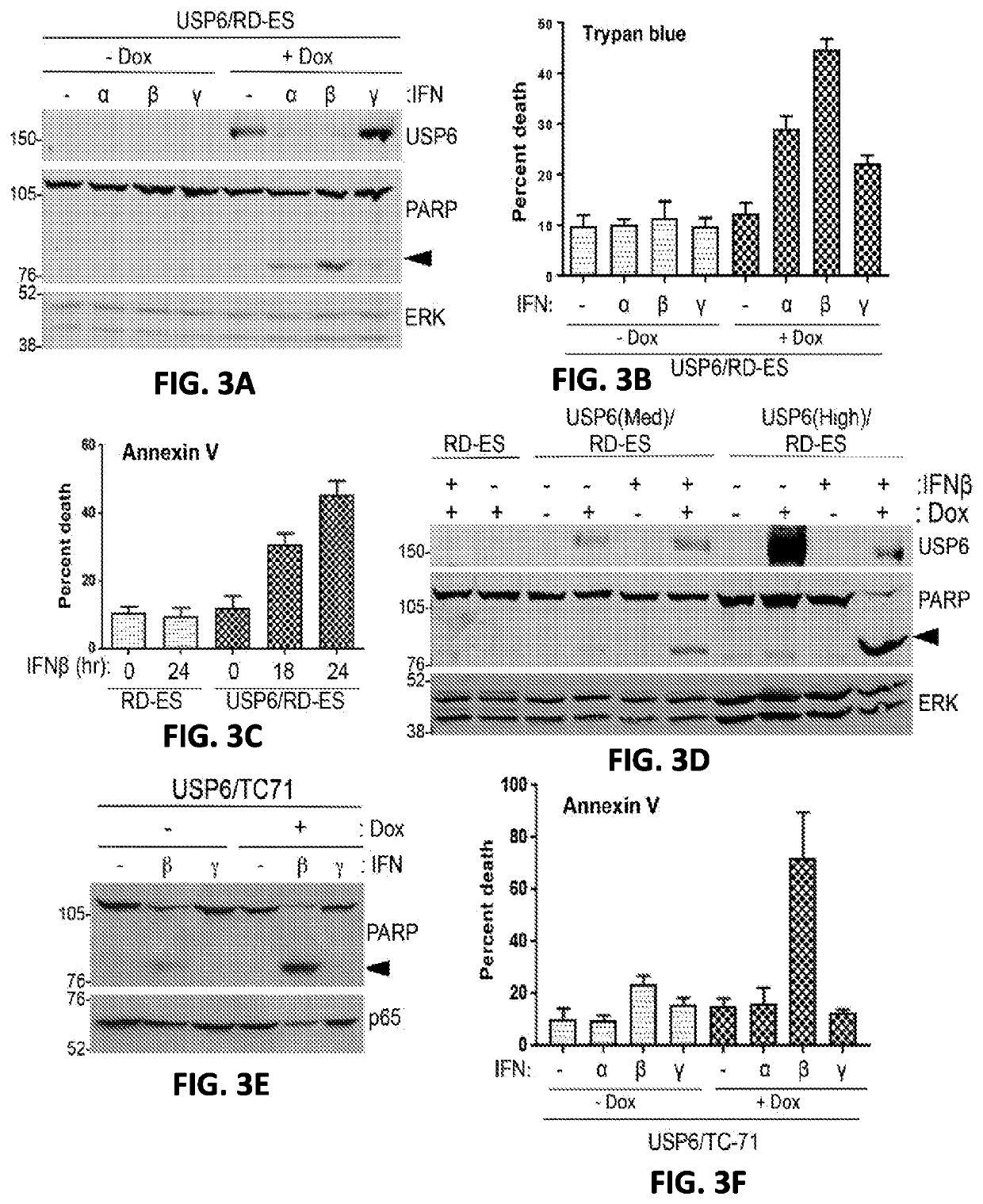Compositions and methods for treating cancer
a technology of compositions and methods, applied in the field of anticancer therapy, can solve the problems of inactive ctls that do manage to penetrate, not all patients have benefited from recent advances in immunotherapy, and significant portion of solid tumors have not been amenable to most immunotherapies, etc., to achieve the effect of increasing the activity of ubiquitin-specific protease 6 (usp6) activity and/or expression
- Summary
- Abstract
- Description
- Claims
- Application Information
AI Technical Summary
Benefits of technology
Problems solved by technology
Method used
Image
Examples
example 1
[0076]Sarcomas are a diverse class of malignancies that represent a significant challenge in oncology. Ewing sarcoma is the second most common bone sarcoma, and typically affects individuals in the first two decades of life (Biswas, et al. (2016) World J. Orthop., 7:527-38). Although patients with localized disease experience 5-year survival rates of 75%, patients with metastatic disease face a dismal survival probability of approximately 20%. Thus, there is an urgent need to identify biomarkers that can predict recurrence and response to therapy, and develop strategies to combat metastatic disease.
[0077]The key etiologic agent in Ewing sarcoma is a translocation product that fuses the EWS RNA-binding protein with an Ets family transcription factor, most commonly FLI1 (Cidre-Aranaz, et al. (2015) Front. Oncol., 5:162). Sustained EWS-FLI1 activity is required for transformation, and significant efforts have been aimed at identifying its critical targets. Multiple effectors that contr...
example 2
[0105]Ubiquitin-specific Peptidase 6 (USP6) stimulates the production of numerous immune-stimulatory factors. USP6 is a hominid-specific gene that is highly restricted in most tissues and organs, with only appreciable expression detected in testis. Among malignancies, it is most highly expressed in several sarcomas, including Ewing sarcoma, but it is uncommonly expressed at high levels in other cancers (Oliveira, et al. (2014) Hum. Pathol., 45(1):1-11; Oliveira, et al. (2005) Oncogene 24(21):3419-26). USP6 is the key etiological agent in two benign bone and soft tissue tumors known as aneurysmal bone cyst (ABC) and nodular fasciitis (NF). In NF and ABC, USP6 undergoes a promoter swapping translocation, resulting in sustained high expression of the wild-type protein. The clinical course of NF is peculiar, with rapid growth followed by spontaneous regression over the course of several weeks or months (Erickson-Johnson, et al. (2011) Lab Invest., 91(10):1427-33). NF lesions exhibit abu...
example 3
[0107]As see in FIG. 8A, acute myeloid leukemia patients with high USP6 expression have a significantly improved prognosis. Similarly, FIG. 8B shows that Ewing sarcoma patients with high USP6 expression have a significantly improved prognosis.
[0108]Ewing sarcoma cell lines TC-71, RD-ES, and CHLA10 were used in additional experiments. Notably, the addition of doxycycline (dox) results in USP6 expression. As seen in FIG. 9, USP6 upregulates the expression of TRAIL-R1 and TRAIL-R2, which hare the receptors for TRAIL, a pro-apoptotic ligand and useful for controlling tumor growth. As seen in FIG. 10, USP6 also upregulates the expression of CD54 (which allows cytotoxic immune cells to bind to target tumor cells) and HLA-ABC / MHC Class I (used by cytotoxic T cells to recognize and kill tumor cells). Natural killer (NK) cells are cytotoxic immune cells that can kill tumor cells. Notably, the induction of USP6 sensitizes tumor cells to the NK cell line NK-92 (FIG. 11).
PUM
| Property | Measurement | Unit |
|---|---|---|
| Fraction | aaaaa | aaaaa |
| Angle | aaaaa | aaaaa |
| Length | aaaaa | aaaaa |
Abstract
Description
Claims
Application Information
 Login to View More
Login to View More - R&D
- Intellectual Property
- Life Sciences
- Materials
- Tech Scout
- Unparalleled Data Quality
- Higher Quality Content
- 60% Fewer Hallucinations
Browse by: Latest US Patents, China's latest patents, Technical Efficacy Thesaurus, Application Domain, Technology Topic, Popular Technical Reports.
© 2025 PatSnap. All rights reserved.Legal|Privacy policy|Modern Slavery Act Transparency Statement|Sitemap|About US| Contact US: help@patsnap.com



